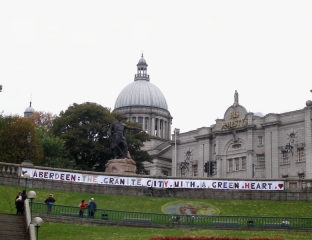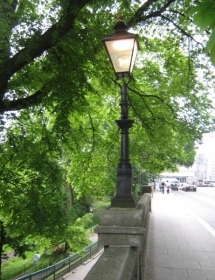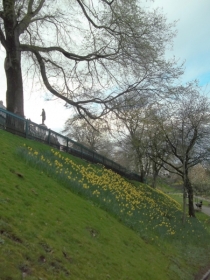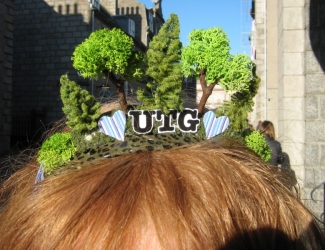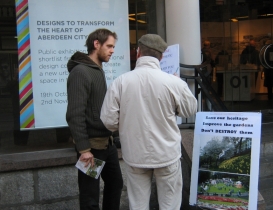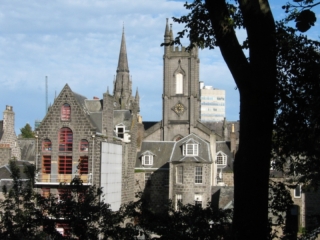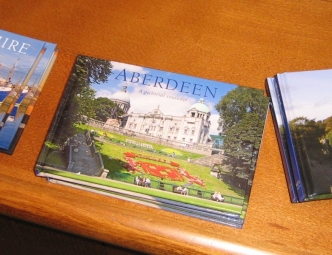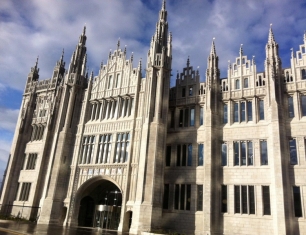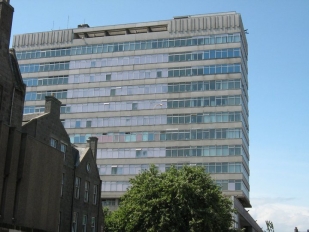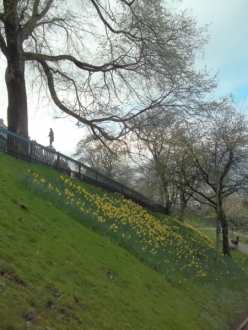Old Susannah looks back at the week that was and wonders who’s up to what and why. By Suzanne Kelly.
The Belmont Cinema’s screening the documentary ‘Just Do It’on Friday 12 August, and has asked me to come along for a discussion. It’s a film about people taking direct action against an unlistening, unmovable government and wealthy, powerful private entities, so it won’t be of much interest to the people of Aberdeen.
I guess they want someone to come along and stick up for the City and its rich business interests, and the Belmont thought of me. If you can make it, it will be at 6.30. Further details to follow.
The dodgy doings in Aberdeen are slightly outshone this week by the continuing twists and turns in the News Corp / News of the World saga. One initial whistle-blower Sean Hoare was mysteriously found dead (‘nothing suspicious’ the police advised almost immediately. A Post Mortem will no doubt confirm this assessment).
People are walking around Parliament with shaving-cream pies unchallenged by our crack security forces, Rupert knows nothing about anything, and Rebekah Brooks deserves an Oscar.
While I commend Private Eye Magazine for its coverage (only going back to 1969 or so) of Murdoch and his bid for world dominance at any cost, I cannot tell you how disappointed I am that it has chosen to criticise our fair city in the same issue.
The Eye implies that something was wrong with the City Garden Monitoring Group’s ‘redacting’ (that’s blacking bits out to you and me) its minutes and reports. Undoubtedly, this was only done after careful thought and for reasons of national security. I therefore hope no one is planning to buy Private Eye No. 1293 (on newsstands now, £1.50, subscription deals available).
I certainly hope no one will be reading its ‘Nooks and Corners’ feature (page 17) where our city’s elected officials are criticised. There is also a piece in this issue entitled ‘Orwellian Nightmare’ – but as it happens, this is not about Aberdeen after all.
Not only are the redacted minutes mentioned in The Eye, but also Mike Shepherd’s open letter to the City regarding Union Terrace Gardens is covered. Mike if you’re out there:– just because the City doesn’t know what’s going to go in the Gardens, or how much it will cost, or what the environmental impact will be, or where the money will come from, or what the external design people are going to do does not necessarily mean the City doesn’t know what it’s doing.
Let’s hope Private Eye stops peering into our City – how else are they getting their information?
fantastic news that we’ve decided to hire some external consultants to figure out our City’s small financial problems
It’s not as if anyone here would be so bold as to contact the Eye (strobes@private-eye.co.uk) and give information – particularly now that the Council has sent letters warning staff not to tell anyone anything about anything ever in any form. I would hate to think of any secrets getting out. Not that there are any secrets of course.
This week I wanted to take another look at how much our City is spending on essentials (like portraits, parties, clothing allowances, consultants, expenses and so on). My curiosity sprang from the fantastic news that we’ve decided to hire some external consultants to figure out our City’s small financial problems.
The vote to hire these consultants may have been taken without any meaningful consultation, and these consultants will cost some £500,000 or more (that’s about £2 quid from each of us). But I somehow feel we’re breaking new ground here by using outside consultants (although I seem to remember when Kate Dean was in charge, and she had absolutely no idea how many millions were spent on consultants).
It will be great having experts on hand – obviously we don’t have any in the City given the small salaries we pay our top people. I’m sure the unions will come around to the City’s way of thinking about consultants and cuts, even if a few jobs may wind up axed. As a reminder, the City collected hundreds of suggestions from its own staff as to how to save money some time ago.
The City will be sharing these suggestions with the consultants (you can refer to them as ‘con men’ for short), and I’ll bet that staff whose ideas are taken up will be financially compensated as well as credited for their ideas. It’s not as if consultants would do anything lazy like take the good ideas on board and pass them off as their own ideas – that’s never going to happen.
I guess this will be a really tough assignment for the consultants – let’s wish them luck and not be surprised if they go a wee bit over budget. Expect some vibrant and dynamic bills to pay for these as-yet unnamed consultants who (I bet) will tell us to outsource services. “What do you mean by ‘outsourcing’?” I hear you say.
Outsource:
(verb, mod English – to move services from public sector control to the private sector).
So Aberdeen’s voted to bring in private consultants who will evaluate if services should be made private. It will all be fine. There is just one funny coincidence when cities outsource services at consultant’s recommendations – the consultants usually pick up more business for helping to implement the outsourcing. It is almost as if the consultants have some kind of incentive to recommend outsourcing.
In the health sector for instance, lots of dosh can be saved
Unkind people think consultants are self-interested greedy unaccountable entities, but nothing could be farther from the truth. Remember, the City is there to make money, not to waste tax money on good services and keeping our environment healthy.
We know from experience in the UK that outsourcing services such as healthcare is always a money-saving way to get better services in the end. Local governments stop directly running services with its own staff, and then private service providers and subcontractors take over the service in question using the cheapest labour available.
Even though private companies exist to make a profit and the taxpayer still has to pay for the services (which almost always cost more when the private sector runs things), then at least the services are off the local authority’s books. Which is a good thing.
In the health sector for instance, lots of dosh can be saved. So what if our hospitals have crumbled, corners have been cut to make money at every turn, infections run rampant, and good nurses are leaving the profession in droves. The private consultants still make money. It’s not as if there have been any scandals, tales of incompetence or abuse of vulnerable people when the private sector takes over.
Usually a local authority puts one or two of its best people on the board of service providers and health boards to ensure perfection is achieved. Grampian Health has Kate Dean for instance. Southern Cross is a shining example of what we can expect in the ‘Deen should we keep outsourcing.
Civic Car
(noun peculiar to Aberdeen – a ride for dignitaries which has been well and truly ‘pimped,’ just in case royalty should come to town for a day or two ever).
I am getting far too excited by the prospect of the unveiling of the Lord Provost’s portrait. I started to wonder how the Lord and his Lady (and the security guard) get around town. I had hoped it was in a pumpkin-shaped horse-drawn coach.
At one point the horrific suggestion was made that the Civic Car should be a second-hand affair!
Do they get around of their own accord? Perhaps by a Honda Accord? No, not an Accord, but a Civic. No, not a Honda Civic – but The Civic Car. (By the way our LP was spotted in Kingswells yesterday morning in some sort of football mum’s 4×4 near a grass verge with 3 other men – but a man like him needs more bling than that).
The existence of the Civic Car explains another excellent use of our Common Good Fund, and I for one could not be happier.
How much does a Civic Car take per year from our collective Common Good fund?
Well, in 2009/10, here are the published figures for the upkeep of said Civic:-
Upkeep of Civic Car: budget £ 51,332; at 31 March 2010 £44,749 ‘estimated out turn’ £53,122
(Figures from Aberdeen City Council)
Clearly the salary isn’t enough to attract anyone to the Lord Provost role; it’s only £28k per year. However, cruising in the Civic car for the Lord Provost alone cost… £23k. In these days of economising, I’m glad to see standards haven’t fallen. At one point the horrific suggestion was made that the Civic Car should be a second-hand affair!
Thankfully, there was no way they could find a second-hand car grand enough for the job, as you would rightly expect. Here’s why this symbol of Aberdeen’s status is more important than your local school, hospital, or service:-
“The level of baseline specification for the Civic Car has to give full consideration to the Lord Provost’s role as Lord-Lieutenant. The Lord Provost is Her Majesty’s representative when in Aberdeen. The official ‘Guide to the Role of Lord-Lieutenants’ says that “it is his first and foremost duty to uphold the dignity of the Crown”. The Civic Car is used during Royal Visits and has been used in the past to transport members of the Royal Family as part of these visits to Aberdeen.
“Other duties of the Lord-Lieutenant are to meet visiting Heads of State within Aberdeen, to represent The Queen or a member of the Royal Family at a funeral or memorial service when requested, to make nominations for invitations to Royal Garden Parties, to offer congratulations of 100th birthdays and significant wedding anniversaries, make nominations for honours and awards, presentation of awards and to support and participate in citizenship ceremonies. During the course of discharging some of these responsibilities, use of the Civic Car by the Lord-Lieutenant or his representative will be necessary”.
I confess: I once allowed myself to imagine what it would be like to be Lord Provost. You’d get the necklace. You’d get the clothing allowance. You’d even get trips to Edinburgh sometimes. But having read the above job description, I realise no ordinary person could do all of that, and I now have the respect for this office that it truly deserves. I hope all you council clerks and office staff realise now how comparatively easy you have it; in fact you might ask yourselves whether you are being overpaid.
And why am I so interested in all the City’s necessary expenditures like parties, flash cars, portraits, statutes, travel abroad and so on? Because John Stewart is so concerned about such things. Stewart’s so worried that in a recent vote concerning the future of Union Terrace Gardens, he put up a motion to ‘change’ the gardens. Part of his motion reads:-
“…that should the competition fail to produce a design acceptable to the Council, officers prepare a report for members detailing the costs of maintaining and enhancing the existing gardens”.
Before we have our very own Lord Provost going about in a second-hand ‘Beamer,’ it would be far smarter to see what those pesky gardens are costing us in petunias and rose bushes.
And quite right. Before we have our very own Lord Provost going about in a second-hand ‘Beamer,’ it would be far smarter to see what those pesky gardens are costing us in petunias and rose bushes. (from the looks of things, we have more than enough free fertiliser in the area). As John famously said, there’s not much in the gardens but grass.
Who’s footing the bill for all this grass? Why isn’t it turning a profit? What can we do to stop this wasteful expense so we can have more to spend on consultants, pictures and parties? Is there a consultant in the house?
In some 9 months you will be asked to vote for councillors; some of whom think they stand a good chance of getting re-elected. These self-sacrificing souls will be happy to hear that Old Susannah will be creating a little matrix of how they’ve voted and what they’ve done (ie kerb-crawling, misappropriation of public funds, and pub slap-ups).
For openers, here are the names of those who agree with John Stewart that we should get a report on the massive costs of keeping UTG going and all that grass growing:
For the amendment by Councillor John Stewart (23) – Lord Provost Peter Stephen (note – it’s great that our Civic Car man and artist’s model wants to save money by cutting out the gardens!) ; Depute Provost Dunbar; and Councillors Corall, Cormack, Cormie, Dean, Donnelly, Fletcher, Jaffrey, Kiddie, Leslie, McCaig, McDonald, Malone, May, Milne, Noble, Robertson, John Stewart, Kevin Stewart, John West, Wisely and Yuill.
I’m going to have to leave it there for now. Between thinking about deer, Union Terrace Gardens, consultants, portraits and civic cars I’m starting to feel a little nauseous again (I was sick the past 4 days with a nasty stomach bug which I wouldn’t wish on my worst enemies. Would I?).
Coming soon: A look at our local government and quango Boards, and hopefully overdue news on my Freedom of Information Requests.
